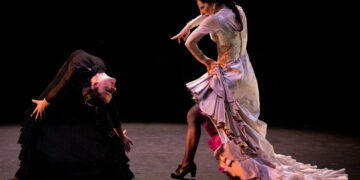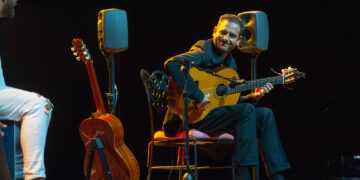|
|
|
Text: Estela Zatania A perfect spring day was the pleasant backdrop for this second installment of the Festival de Jerez. At the San Ginés Bodega, after the customary presentations by those to perform the following day, there was a round-table talk devoted to Vicente Escudero, and at seven in the evening, the prizes for best artists corresponding to last year’s festival were awarded to Joaquín Grilo, Fernando Belmonte, Juana la del Pipa, Olga Pericet and Matilde Coral. LA FARRUCA “HOMENAJE A LOS GRANDES” Dance: La Farruca, Manuel “El Carpeta”. Cante: Pedro El Granaíno, Fabiola Pérez, Mara Rey. Guitar: Juan Requena, José Acedo. Piano: Pablo Rubén Maldonado Six dances to pay tribute to six dancers. An elegantly simple concept was the key to success for this show from the matriarch of the Farruco dynasty.
The program had a neat layout: taranto to remember Fernanda Romero, alegrías to recall the first Farruquito, brother of La Farruca, cantiñas in honor of Matilde Coral (who was in the audience), a Caracol zambra for Lola Flores, seguiriyas in memory of Carmen Amaya and soleá for the late Farruco senior whose personality and dynamic force continue to be the psychic food and impetus that move this family. La Farruca has managed to keep her own identity within a group of phenomenal dancers. The family line is based on a masculine style of speed, strength and unabashed macho-ism. But the daughter of old Farruco had the intelligence and sensitivity to define her own personal feline intensity within this concept she has developed so admirably. Now she hopes to retire from dance, and announced this show would be her last. But within the breadth of possibilities provided by traditional flamenco, the night had two surprising stars. In 2003, exactly eight years ago, we discovered little Carpeta, youngest son of La Farruca. Only five at the time, he already was astonishing with his rhythm and knowledge. Now, at thirteen, he is very close to becoming a major force in flamenco dance, and last night’s performance, not the typical short bit at the end of a show, but an alegrías dance, felt like the presentation to flamenco society of this little genius in a red satin suit. The other star of the night was singer Pedro el Granaíno. He’s been singing backup in the family’s shows for years, without ever having the opportunity to demonstrate his capacity and personality. In this ‘tribute to the greats’, with a varied series of difficult cantes that were the backbone of the work, he not only masterfully evoked Caracol for Farruca’s “Lola Flores”, but recreated the work of other historic maestros of cante, and gave substance to a large part of the show with the toasted honey of his Camarón delivery. SANTIAGO LARA TRÍO “AMALGAMA” At midnight in the Sala Paúl, a venue reserved for young artists and small formats, with the series “De la Frontera”, guitarist Santiago Lara offered a recital of contemporary guitar with the back-up of Miguel Ángel López on piano, and Antonio Coronel on percussion, in addition to the spectacular collaboration of the guitarist’s wife, dancer Mercedes Ruiz. Following the outline of the recital he gave several months ago at the Bienal de Sevilla, Lara played a series of original compositions with a distinct jazz flavor and aesthetic. His excellent preparation alongside master guitarist Manolo Sanlúcar, allows him to explore and investigate without losing the flamenco thread, although I would have liked him to assume a larger role and give less of the spotlight to the piano and percussion. As occurred in Seville, Mercedes drew the most effusive applause with her elegant dancing that successfully mixes historic and contemporary references. At one o’clock in the morning, at the Tío José de Paula peña in the neighborhold of Santiago, those who were in the mood for traditional flamenco in an informal setting were able to enjoy the Garbanzo flamenco group. |
Descubre más desde Revista DeFlamenco.com
Suscríbete y recibe las últimas entradas en tu correo electrónico.



 If last night La Farruca was not as dynamic as she has been at other times in the past, or wore an absolutely ill-advised dress for the first dance, these were insignificant considerations in a fine show that had no greater ambition than to show flamenco in all its expressive capacity, and pay tribute to some of the genre’s most noteworthy interpreters. The previous day, Antonio el Pipa also put his bets on classic flamenco. Is it possible that the tiresome experimentation that has been the norm in flamenco in recent decades is losing steam? I seriously doubt it, but a new economic landscape is forcing people to get real, and only true artists float to the surface.
If last night La Farruca was not as dynamic as she has been at other times in the past, or wore an absolutely ill-advised dress for the first dance, these were insignificant considerations in a fine show that had no greater ambition than to show flamenco in all its expressive capacity, and pay tribute to some of the genre’s most noteworthy interpreters. The previous day, Antonio el Pipa also put his bets on classic flamenco. Is it possible that the tiresome experimentation that has been the norm in flamenco in recent decades is losing steam? I seriously doubt it, but a new economic landscape is forcing people to get real, and only true artists float to the surface.
























